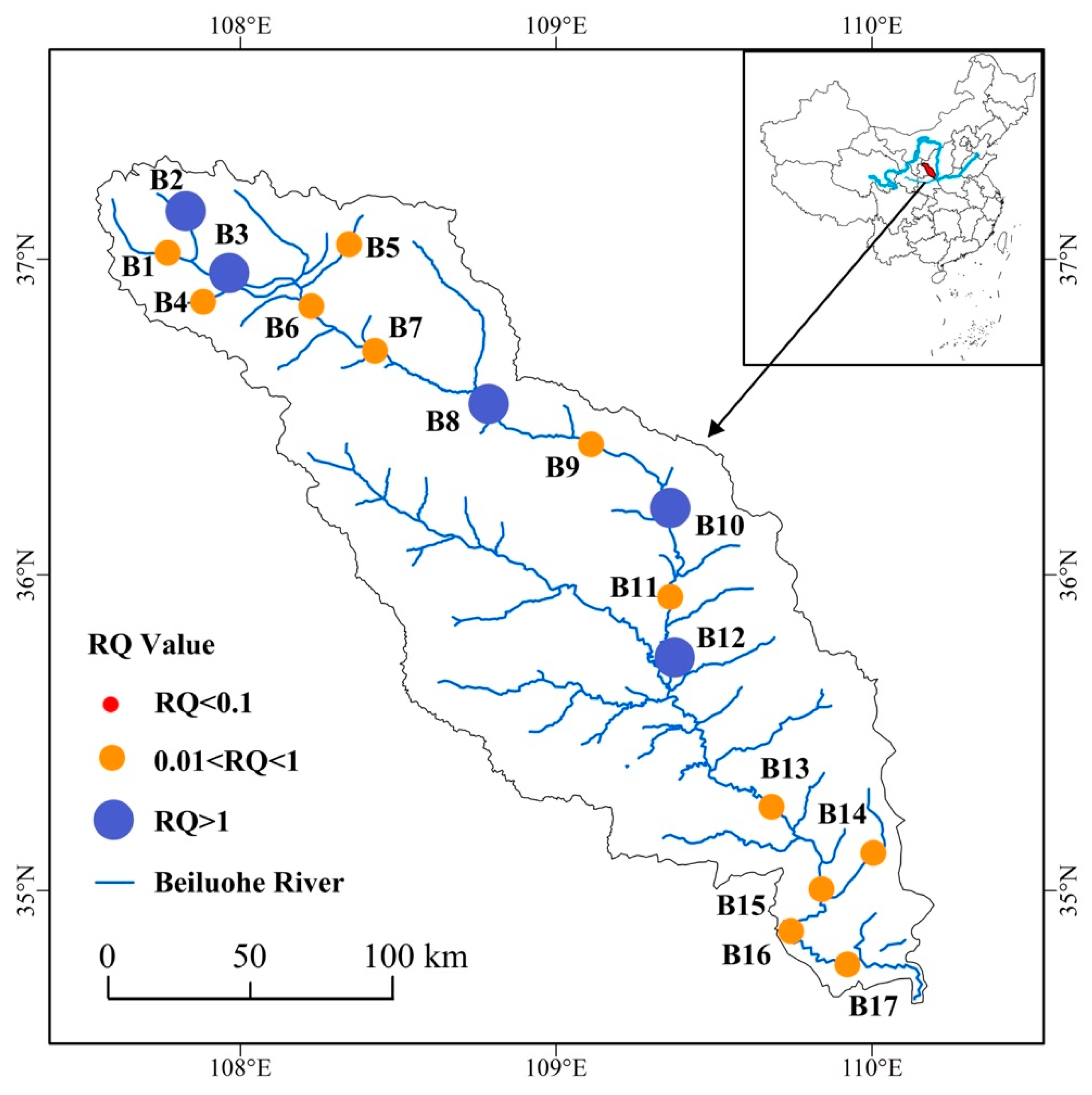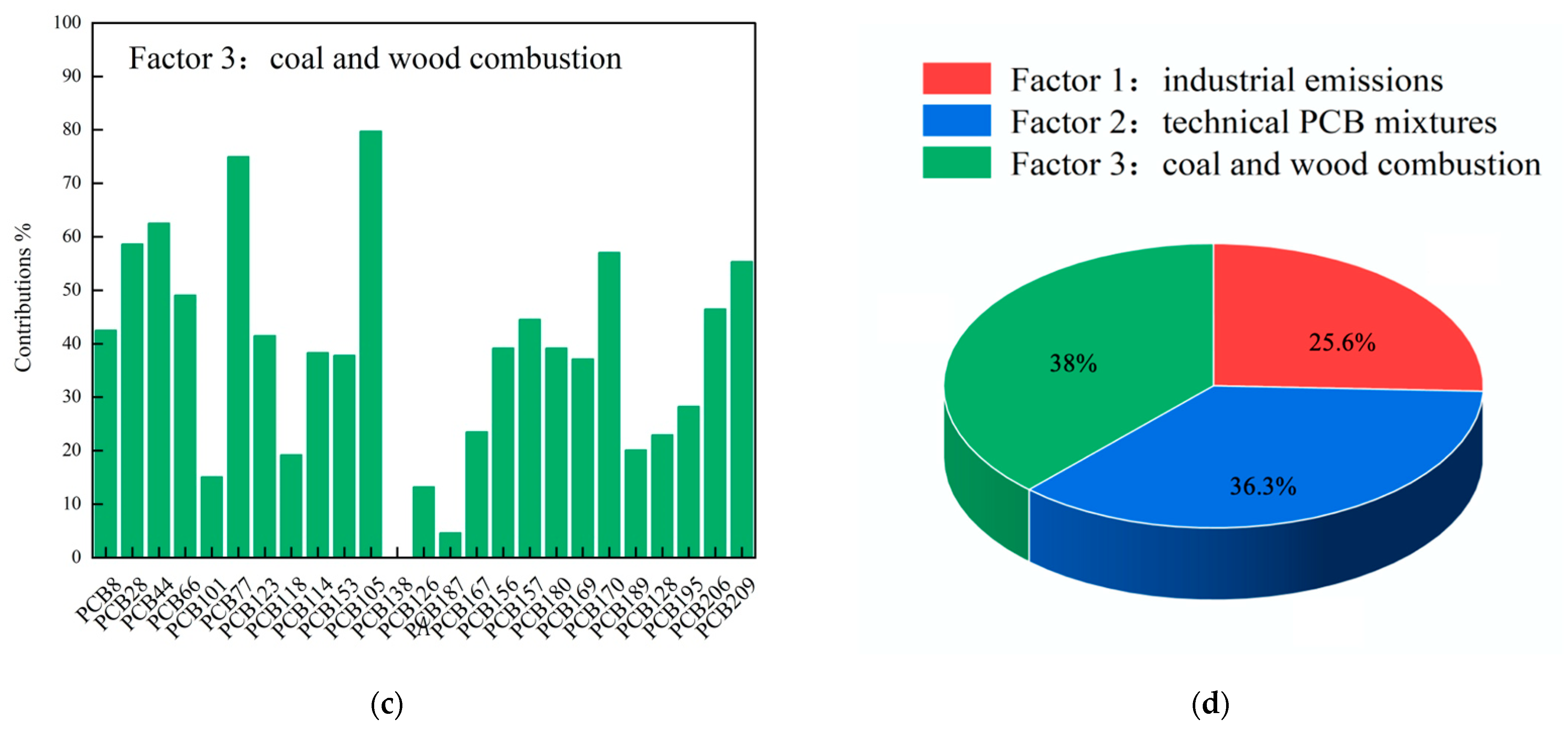Occurrence, Potential Risk Assessment, and Source Apportionment of Polychlorinated Biphenyls in Water from Beiluo River
Abstract
:1. Introduction
2. Materials and Methods
2.1. Study Area and Sampling
2.2. Sample Pre-Treatment and Instrumental Analysis
2.3. Ecological Risk Assessment Methods
2.4. PCBs Source Apportionment by Positive Matrix Factorization (PMF)
2.5. Statistical Analyses
3. Results and Discussion
3.1. PCB Concentrations and Congener Profiles
3.2. Ecological Risk Assessment
3.3. Source Apportionment of PCBs by Positive Matrix Factorization (PMF)
3.4. Implications for Control Measures
4. Conclusions
- We found 28 different PCB types, with concentrations ranging from 0.065 to 1.92 ng L−1, in the analyzed items. Furthermore, the average was 0.37 ng L−1. The pollution was on a moderate level when compared with other comparable lakes, bays, or water samples. PCBs were primarily high chlorinated (>5 Cl) at all sampling sites, accounting for 82.03% of the total. Only 17.97% of PCBs are less chlorinated (5 Cl), which is a rather small fraction;
- According to an assessment of ecosystem risk, PCB128, PCB206, and PCB209 in the Beiluo River Basin generally showed middle-level ecosystem risk, while PCB77, PCB126, PCB189, and PCB195 only showed moderate pollution risk at specific sampling sites, and PCB18, PCB28, PCB44, PCB52, PCB66, PCB81, PCB101, PCB105, PCB114, PCB123, PCB156, and PCB157 showed no ecosystem risk at any site. At sampling point B2, only PCB128 is high risk. Therefore, it is important to constantly analyze the pollution levels in the Beiluo River in order to determine the ecological risk;
- The PMF model’s source apportionment of PCBs indicates that combustion-related sources, commercial PCB mixtures, and industrial emissions were the main sources of PCBs in the Beiluo River, contributing 25.63%, 36.33%, and 38.05% of total PCBs, respectively.
Supplementary Materials
Author Contributions
Funding
Institutional Review Board Statement
Informed Consent Statement
Data Availability Statement
Conflicts of Interest
References
- Mitra, S.; Corsolini, S.; Pozo, K.; Audy, O.; Sarkar, S.K.; Biswas, J.K. Characterization, source identification and risk associated with polyaromatic and chlorinated organic contaminants (PAHs, PCBs, PCBzs and OCPs) in the surface sediments of Hooghly estuary, India. Chemosphere 2019, 221, 154–165. [Google Scholar] [CrossRef] [PubMed]
- Wang, Q.; Yang, Z.M. Industrial water pollution, water environment treatment, and health risks in China. Environ. Pollut. 2016, 218, 358–365. [Google Scholar] [CrossRef] [PubMed]
- Cui, M.K.; Xu, S.L.; Song, W.Q.; Ye, H.B.; Huang, J.L.; Liu, B.H.; Dong, B.; Xu, Z.X. Trace metals, polycyclic aromatic hydrocarbons and polychlorinated biphenyls in the surface sediments from Sanya River, China: Distribution, sources and ecological risk. Environ. Pollut. 2022, 294, 118614. [Google Scholar] [CrossRef] [PubMed]
- Wang, W.; Bai, J.H.; Zhang, G.L.; Jia, J.; Wang, X.; Liu, X.H.; Cui, B.S. Occurrence, sources and ecotoxicological risks of polychlorinated biphenyls (PCBs) in sediment cores from urban, rural and reclamation-affected rivers of the Pearl River Delta, China. Chemosphere 2019, 218, 359–367. [Google Scholar] [CrossRef]
- Jepson, P.D.; Deaville, R.; Barber, J.L.; Aguilar, A.; Borrell, A.; Murphy, S.; Barry, J.; Brownlow, A.; Barnett, J.; Berrow, S.; et al. PCB pollution continues to impact populations of orcas and other dolphins in European waters. Sci. Rep. 2016, 6, 18573. [Google Scholar] [CrossRef] [Green Version]
- Mao, S.D.; Liu, S.R.; Zhou, Y.T.; An, Q.; Zhou, X.J.; Mao, Z.Y.; Wu, Y.T.; Liu, W.P. The occurrence and sources of polychlorinated biphenyls (PCBs) in agricultural soils across China with an emphasis on unintentionally produced PCBs. Environ. Pollut. 2021, 271, 116171. [Google Scholar] [CrossRef]
- Qu, C.; Albanese, S.; Lima, A.; Hope, D.; Pond, P.; Fortelli, A.; Romano, N.; Cerino, P.; Pizzolante, A.; De Vivo, B. The occurrence of OCPs, PCBs, and PAHs in the soil, air, and bulk deposition of the Naples metropolitan area, southern Italy: Implications for sources and environmental processes. Environ Int 2019, 124, 89–97. [Google Scholar] [CrossRef]
- Qu, C.; Albanese, S.; Cicchella, D.; Fortelli, A.; Hope, D.; Esposito, M.; Cerino, P.; Pizzolante, A.; Qi, S.; De Vivo, B.; et al. The contribution of persistent organic pollutants to the environmental changes in Campania region, Italy: Results from the Campania Trasparente project. J. Geochem. Explor. 2022, 241. [Google Scholar] [CrossRef]
- Ragab, S.; El Sikaily, A.; El Nemr, A. Concentrations and sources of pesticides and PCBs in surficial sediments of the Red Sea coast, Egypt. Egypt. J. Aquat. Res. 2016, 42, 365–374. [Google Scholar] [CrossRef] [Green Version]
- Zhang, H.B.; Li, X.H.; Luo, Y.M.; Li, Q.B. Depth distribution of polychlorinated biphenyls in soils of the Yangtze River Delta region, China. Geoderma 2011, 160, 408–413. [Google Scholar] [CrossRef]
- Wang, Y.; Luo, C.L.; Li, J.; Yin, H.; Li, X.D.; Zhang, G. Characterization and risk assessment of polychlorinated biphenyls in soils and vegetations near an electronic waste recycling site, South China. Chemosphere 2011, 85, 344–350. [Google Scholar] [CrossRef]
- Xing, Y.; Lu, Y.; Dawson, R.W.; Shi, Y.; Zhang, H.; Wang, T.; Liu, W.; Ren, H. A spatial temporal assessment of pollution from PCBs in China. Chemosphere 2005, 60, 731–739. [Google Scholar] [CrossRef]
- Takasuga, T.; Senthilkumar, K.; Matsumura, T.; Shiozaki, K.; Sakai, S.I. Isotope dilution analysis of polychlorinated biphenyls (PCBs) in transformer oil and global commercial PCB formulations by high resolution gas chromatography-high resolution mass spectrometry. Chemosphere 2006, 62, 469–484. [Google Scholar] [CrossRef] [PubMed]
- Erickson, M.D.; Kaley, R.G. Applications of polychlorinated biphenyls. Environ. Sci. Pollut. Res. 2011, 18, 135–151. [Google Scholar] [CrossRef]
- Li, J.; Chen, C.L.; Li, F.D. Status of POPs accumulation in the Yellow River Delta: From distribution to risk assessment. Mar. Pollut. Bull. 2016, 107, 370–378. [Google Scholar] [CrossRef] [PubMed] [Green Version]
- Duan, X.Y.; Li, Y.X.; Li, X.G.; Li, M.F.; Zhang, D.H. Distributions and sources of polychlorinated biphenyls in the coastal East China Sea sediments. Sci. Total. Environ. 2013, 463, 894–903. [Google Scholar] [CrossRef] [PubMed]
- Wang, N.; Yi, L.; Shi, L.L.; Kong, D.Y.; Cai, D.J.; Wang, D.H.; Shan, Z.J. Pollution level and human health risk assessment of some pesticides and polychlorinated biphenyls in Nantong of Southeast China. J. Environ. Sci. 2012, 24, 1854–1860. [Google Scholar] [CrossRef]
- Sun, H.; Chen, H.; Yao, L.; Chen, J.; Zhu, Z.; Wei, Y.; Ding, X.; Chen, J. Sources and health risks of PM(2.5)-bound polychlorinated biphenyls (PCBs) and organochlorine pesticides (OCPs) in a North China rural area. J. Environ. Sci. 2020, 95, 240–247. [Google Scholar] [CrossRef] [PubMed]
- Chen, X.; Chen, J.S.; Zhang, L.; Li, J.G.; Yao, L.N.; Self, S.G.; Sun, X.; Tang, N.J. Levels of PCDDs, PCDFs and dl-PCBs in the blood of childbearing-aged women living in the vicinity of a chemical plant in Tianjin: A primary study. Chemosphere 2015, 118, 1–4. [Google Scholar] [CrossRef]
- Cave, M.; Appana, S.; Patel, M.; Falkner, K.C.; McClain, C.J.; Brock, G. Polychlorinated Biphenyls, Lead, and Mercury Are Associated with Liver Disease in American Adults: NHANES 2003-2004. Environ. Health Persp. 2010, 118, 1735–1742. [Google Scholar] [CrossRef] [PubMed] [Green Version]
- Nagayama, J.; Okamura, K.; Iida, T.; Hirakawa, H.; Matsueda, T.; Tsuji, H.; Hasegawa, M.; Sato, K.; Ma, H.Y.; Yanagawa, T.; et al. Postnatal exposure to chlorinated dioxins and related chemicals on thyroid hormone status in Japanese breast-fed infants. Chemosphere 1998, 37, 1789–1793. [Google Scholar] [CrossRef] [PubMed]
- Bell, M.R. Endocrine-disrupting actions of PCBs on brain development and social and reproductive behaviors. Curr. Opin. Pharmacol. 2014, 19, 134–144. [Google Scholar] [CrossRef] [PubMed] [Green Version]
- Cheng, J.; Yang, Y.; Ma, J.; Wang, W.; Liu, X.; Sakamoto, M.; Qu, Y.; Shi, W. Assessing noxious effects of dietary exposure to methylmercury: PCBs and Se coexisting in environmentally contamined rice in male mice. Environ. Int. 2009, 35, 619–625. [Google Scholar] [CrossRef] [PubMed]
- Zhang, L.; Shi, K.L.; Yue, L.P. Chemical characteristics and pollution sources of petroleum hydrocarbons and PAHs in sediments from the Beiluo River, Northern China. Environ. Geol. 2007, 53, 307–315. [Google Scholar] [CrossRef]
- He, Y.; Song, J.; Hu, Y.; Tu, X.; Zhao, Y. Impacts of different weather conditions and landuse change on runoff variations in the Beiluo River Watershed, China. Sustain. Cities Soc. 2019, 50, 101674. [Google Scholar] [CrossRef]
- Chen, N.; Ma, T.; Zhang, X. Responses of soil erosion processes to land cover changes in the Loess Plateau of China: A case study on the Beiluo River basin. Catena 2015, 136, 118–127. [Google Scholar] [CrossRef]
- Zhang, Y.X.; Cheng, D.D.; Lei, Y.L.; Song, J.X.; Xia, J. Spatiotemporal distribution of polycyclic aromatic hydrocarbons in sediments of a typical river located in the Loess Plateau, China: Influence of human activities and land-use changes. J. Hazard. Mater. 2022, 424, 127744. [Google Scholar] [CrossRef]
- 2020 Yan’an Statistical Yearbook. 2020. Available online: http://tjj.yanan.gov.cn/tjxx/tjsj/tjnj/1535078906934181889.html (accessed on 21 October 2022).
- Jiang, W.W.; Song, J.X.; Zhang, J.L.; Wang, Y.Y.; Zhang, N.; Zhang, X.H.; Long, Y.Q.; Li, J.X.; Yang, X.G. Spatial variability of streambed vertical hydraulic conductivity and its relation to distinctive stream morphologies in the Beiluo River, Shaanxi Province, China. Hydrogeol. J. 2015, 23, 1617–1626. [Google Scholar] [CrossRef]
- Chinese Industrial Standard, 2017. Soil and Sediment–Determination of Polychlorinated Biphenyl Mixtures–Gas Chromatography. HJ 890; Ministry of Ecology and Environment of People’s Republic of China: Beijing, China, 2017. (In Chinese)
- Zheng, H.; Qu, C.; Zhang, J.; Talpur, S.A.; Ding, Y.; Xing, X.; Qi, S. Polycyclic aromatic hydrocarbons (PAHs) in agricultural soils from Ningde, China: Levels, sources, and human health risk assessment. Env. Geochem. Health 2019, 41, 907–919. [Google Scholar] [CrossRef]
- Yang, Z.F.; Shen, Z.Y.; Gao, F.; Tang, Z.W.; Niu, J.F. Occurrence and possible sources of polychlorinated biphenyls in surface sediments from the Wuhan reach of the Yangtze River, China. Chemosphere 2009, 74, 1522–1530. [Google Scholar] [CrossRef]
- Van den Berg, M.; Birnbaum, L.S.; Denison, M.; De Vito, M.; Farland, W.; Feeley, M.; Fiedler, H.; Hakansson, H.; Hanberg, A.; Haws, L.; et al. The 2005 World Health Organization reevaluation of human and mammalian toxic equivalency factors for dioxins and dioxin-like compounds. Toxicol. Sci. 2006, 93, 223–241. [Google Scholar] [CrossRef] [PubMed] [Green Version]
- Shi, C.; Qu, C.; Sun, W.; Zhou, J.; Zhang, J.; Cao, Y.; Zhang, Y.; Guo, J.; Zhang, J.; Qi, S. Multimedia distribution of polycyclic aromatic hydrocarbons in the Wang Lake Wetland, China. Environ Pollut 2022, 306, 119358. [Google Scholar] [CrossRef]
- Sah, R.; Baroth, A.; Hussain, S.A. First account of spatio-temporal analysis, historical trends, source apportionment and ecological risk assessment of banned organochlorine pesticides along the Ganga River. Environ. Pollut. 2020, 263, 114229. [Google Scholar] [CrossRef]
- Wang, X.N.; Zhang, Z.M.; Zhang, R.R.; Huang, W.; Dou, W.K.; You, J.J.; Jiao, H.F.; Sun, A.L.; Chen, J.; Shi, X.Z.; et al. Occurrence, source, and ecological risk assessment of organochlorine pesticides and polychlorinated biphenyls in the water-sediment system of Hangzhou Bay and East China Sea. Mar. Pollut. Bull. 2022, 179, 113735. [Google Scholar] [CrossRef] [PubMed]
- Wang, Z.; Qu, C.; Zhang, J.; Zhi, L.; Tang, T.; Yao, H.; Li, W.; Shi, C.; Qi, S. Constructing model-averaging species sensitivity distributions of Phenanthrene based on reproductive fitness: Implications for assessing ecological risk in urban watershed. J. Hazard. Mater. 2023, 443, 130296. [Google Scholar] [CrossRef] [PubMed]
- Du, S.Y.; Rodenburg, L.A. Source identification of atmospheric PCBs in Philadelphia/Camden using positive matrix factorization followed by the potential source contribution function. Atmos Environ. 2007, 41, 8596–8608. [Google Scholar] [CrossRef]
- Yurdakul, S.; Celik, I.; Celen, M.; Ozturk, F.; Cetin, B. Levels, temporal/spatial variations and sources of PAHs and PCBs in soil of a highly industrialized area. Atmos Pollut. Res. 2019, 10, 1227–1238. [Google Scholar] [CrossRef]
- Chen, Y.P.; Zhao, Y.; Zhao, M.M.; Wu, J.H.; Wang, K.B. Potential health risk assessment of HFRs, PCBs, and OCPs in the Yellow River basin. Environ. Pollut. 2021, 275, 116648. [Google Scholar] [CrossRef]
- Howell, N.L.; Suarez, M.P.; Rifai, H.S.; Koenig, L. Concentrations of polychlorinated biphenyls (PCBs) in water, sediment, and aquatic biota in the Houston Ship Channel, Texas. Chemosphere 2008, 70, 593–606. [Google Scholar] [CrossRef]
- Wang, D.G.; Yang, M.; Jia, H.L.; Zhou, L.; Li, Y.F. Levels, distributions and profiles of polychlorinated biphenyls in surface soils of Dalian, China. Chemosphere 2008, 73, 38–42. [Google Scholar] [CrossRef]
- Odabasi, M.; Bayram, A.; Elbir, T.; Seyfioglu, R.; Dumanoglu, Y.; Bozlaker, A.; Demircioglu, H.; Altiok, H.; Yatkin, S.; Cetin, B. Electric Arc Furnaces for Steel-Making: Hot Spots for Persistent Organic Pollutants. Environ. Sci. Technol. 2009, 43, 5205–5211. [Google Scholar] [CrossRef] [PubMed]
- Jafarabadi, A.R.; Bakhtiari, A.R.; Mitra, S.; Maisano, M.; Cappello, T.; Jadot, C. First polychlorinated biphenyls (PCBs) monitoring in seawater, surface sediments and marine fish communities of the Persian Gulf: Distribution, levels, congener profile and health risk assessment. Environ. Pollut. 2019, 253, 78–88. [Google Scholar] [CrossRef] [PubMed]
- Pouch, A.; Zaborska, A.; Mazurkiewicz, M.; Winogradow, A.; Pazdro, K. PCBs, HCB and PAHs in the seawater of Arctic fjords–Distribution, sources and risk assessment. Mar. Pollut. Bull. 2021, 164, 111980. [Google Scholar] [CrossRef] [PubMed]
- Moret, I.; Gambaro, A.; Piazza, R.; Ferrari, S.; Manodori, L. Determination of polychlorobiphenyl congeners (PCBs) in the surface water of the Venice lagoon. Mar. Pollut. Bull. 2005, 50, 167–174. [Google Scholar] [CrossRef]
- Montuori, P.; De Rosa, E.; Sarnacchiaro, P.; Di Duca, F.; Provvisiero, D.P.; Nardone, A.; Triassi, M. Polychlorinated biphenyls and organochlorine pesticides in water and sediment from Volturno River, Southern Italy: Occurrence, distribution and risk assessment. Environ. Sci. Eur. 2020, 32, 123. [Google Scholar] [CrossRef]
- Nie, X.; Lan, C.Y.; Luan, T.; Huang, M.H.; Mai, Z.Q. Polychlorinated biphenyls in the waters, sediments and benthic organisms from Guangzhou reach of Pearl River. Zhongguo Huanjing Kexue/China Environ. Sci. 2001, 21, 417–421. [Google Scholar]
- Chunxia, W. Monitoring toxic organic pollutants in Huaihe River waters using SPE and triolein-SPMD. China Environ. Sci. 2000, 20, 168–172. [Google Scholar]
- Zhang, R.; Kang, Y.; Yu, K.-F.; Han, M.; Wang, Y.; Huang, X.; Ding, Y.; Wang, R.; Pei, J. Occurrence, Distribution, and Fate of Polychlorinated Biphenyls (PCBs) in Multiple Coral Reef Regions from the South China Sea: A Case Study in Spring-summer. Sci. Total Environ. 2021, 777, 146106. [Google Scholar] [CrossRef]
- Sun, H.W.; Giesy, J.P.; Jin, X.W.; Wang, J. Tiered probabilistic assessment of organohalogen compounds in the Han River and Danjiangkou Reservoir, central China. Sci. Total Environ. 2017, 586, 163–173. [Google Scholar] [CrossRef]
- Zaghden, H.; Barhoumi, B.; Jlaiel, L.; Guigue, C.; Chouba, L.; Touil, S.; Sayadi, S.; Tedetti, M. Occurrence, origin and potential ecological risk of dissolved polycyclic aromatic hydrocarbons and organochlorines in surface waters of the Gulf of Gabès (Tunisia, Southern Mediterranean Sea). Mar. Pollut. Bull. 2022, 180, 113737. [Google Scholar] [CrossRef]
- Miraji, H.; Ripanda, A.; Moto, E. A review on the occurrences of persistent organic pollutants in corals, sediments, fish and waters of the Western Indian Ocean. Egypt. J. Aquat. Res. 2021, 47, 373–379. [Google Scholar] [CrossRef]
- Dioxins. Office of Dioxins Control, Environmental Management Bureau, Ministry of the Environment, Government of Japan. 2012. Available online: https://www.env.go.jp/en/chemi/dioxins/brochure2012.pdf (accessed on 23 October 2022).
- Habibullah-Al-Mamun, M.; Ahmed, M.K.; Islam, M.S.; Tokumura, M.; Masunaga, S. Occurrence, distribution and possible sources of polychlorinated biphenyls (PCBs) in the surface water from the Bay of Bengal coast of Bangladesh. Ecotox. Environ. Safe 2019, 167, 450–458. [Google Scholar] [CrossRef] [PubMed]
- Yang, Y.J.; Chen, Z.L.; Zhang, J.L.; Wu, S.Q.; Yang, L.; Chen, L.; Shao, Y. The challenge of micropollutants in surface water of the Yangtze River. Sci. Total Environ. 2021, 780, 146537. [Google Scholar] [CrossRef] [PubMed]
- Wang, H.S.; Du, J.; Leung, H.M.; Leung, A.O.; Liang, P.; Giesy, J.P.; Wong, C.K.; Wong, M.H. Distribution and source apportionments of polychlorinated biphenyls (PCBs) in mariculture sediments from the Pearl River Delta, South China. Mar. Pollut. Bull. 2011, 63, 516–522. [Google Scholar] [CrossRef]
- Shao, Y.; Chen, Z.L.; Hollert, H.; Zhou, S.B.; Deutschmann, B.; Seiler, T.B. Toxicity of 10 organic micropollutants and their mixture: Implications for aquatic risk assessment. Sci. Total Environ. 2019, 666, 1273–1282. [Google Scholar] [CrossRef]
- Wu, B.B.; Zhang, Y.L.; Hong, H.C.; Hu, M.; Liu, H.L.; Chen, X.; Liang, Y. Hydrophobic organic compounds in drinking water reservoirs: Toxic effects of chlorination and protective effects of dietary antioxidants against disinfection by-products. Water Res. 2019, 166, 115041. [Google Scholar] [CrossRef]
- Khalil, S.; Mahnashi, M.H.; Hussain, M.; Zafar, N.; Nisa, W.U.; Khan, F.S.; Afzal, U.; Shah, G.M.; Niazi, U.M.; Awais, M.; et al. Exploration and determination of algal role as Bioindicator to evaluate water quality-Probing freshwater algae. Saudi, J. Biol. Sci. 2021, 28, 5728–5737. [Google Scholar] [CrossRef]
- Yuan, Z.; He, B.; Wu, X.; Simonich, S.L.M.; Liu, H.; Fu, J.; Chen, A.; Liu, H.; Wang, Q. Polycyclic aromatic hydrocarbons (PAHs) in urban stream sediments of Suzhou Industrial Park, an emerging eco-industrial park in China: Occurrence, sources and potential risk. Ecotoxicol. Environ. Saf. 2021, 214, 112095. [Google Scholar] [CrossRef]
- Anezaki, K.; Nakano, T.; Kashiwagi, N. Estimation of Polychlorinated Biphenyl Sources in Industrial Port Sediments Using a Bayesian Semifactor Model Considering Unidentified Sources. Environ. Sci. Technol. 2016, 50, 765–771. [Google Scholar] [CrossRef]
- Zhao, T.G.; Guo, Z.G.; Yao, P.; Hu, L.M.; Wu, Z.L.; Lin, T. Deposition flux and mass inventory of polychlorinated biphenyls in sediments of the Yangtze River Estuary and inner shelf, East China Sea: Implications for contributions of large-river input and e-waste dismantling. Sci. Total Environ. 2019, 647, 1222–1229. [Google Scholar] [CrossRef]
- Yan, W.Z.; Hua, S. A Strategy Study on the Environmental Protection of the Energy and Chemical Industry Base in Northern Shaanxi. Energy Procedia 2011, 5, 969–973. [Google Scholar] [CrossRef] [Green Version]
- Song, J.X.; Yang, Z.Y.; Xia, J.; Cheng, D.D. The impact of mining-related human activities on runoff in northern Shaanxi, China. J. Hydrol. 2021, 598, 126235. [Google Scholar] [CrossRef]
- Jin, R.H.; Park, S.U.; Park, J.E.; Kim, J.G. Polychlorinated Biphenyl Congeners in River Sediments: Distribution and Source Identification Using Multivariate Factor Analysis. Arch. Environ. Con. Tox. 2012, 62, 411–423. [Google Scholar] [CrossRef]
- Cui, S.; Fu, Q.; Ma, W.L.; Song, W.W.; Liu, L.Y.; Li, Y.F. A preliminary compilation and evaluation of a comprehensive emission inventory for polychlorinated biphenyls in China. Sci. Total Environ. 2015, 533, 247–255. [Google Scholar] [CrossRef]
- Zhao, S.Z.; Breivik, K.; Liu, G.R.; Zheng, M.H.; Jones, K.C.; Sweetman, A.J. Long-Term Temporal Trends of Polychlorinated Biphenyls and Their Controlling Sources in China. Environ. Sci. Technol. 2017, 51, 2838–2845. [Google Scholar] [CrossRef] [Green Version]
- Lee, R.G.; Coleman, P.; Jones, J.L.; Jones, K.C.; Lohmann, R. Emission factors and importance of PCDD/Fs, PCBs, PCNs, PAHs and PM10 from the domestic burning of coal and wood in the U.K. Environ. Sci. Technol. 2005, 39, 1436–1447. [Google Scholar] [CrossRef]
- Kim, K.S.; Hirai, Y.; Kato, M.; Urano, K.; Masunaga, S. Detailed PCB congener patterns in incinerator flue gas and commercial PCB formulations (Kanechlor). Chemosphere 2004, 55, 539–553. [Google Scholar] [CrossRef]
- Aydin, Y.M.; Kara, M.; Dumanoglu, Y.; Odabasi, M.; Elbir, T. Source apportionment of polycyclic aromatic hydrocarbons (PAHs) and polychlorinated biphenyls (PCBs) in ambient air of an industrial region in Turkey. Atmos Environ. 2014, 97, 271–285. [Google Scholar] [CrossRef]
- Sun, H.; Chen, Q.; Chen, W.; Qu, C.; Mo, J.; Song, J.; Guo, J.; Tian, Y. Assessment of biological community in riparian zone contaminated by PAHs: Linking source apportionment to biodiversity. Sci. Total Environ. 2022, 851, 158121. [Google Scholar] [CrossRef]
- Yang, J.; Qadeer, A.; Liu, M.; Zhu, J.M.; Huang, Y.P.; Du, W.N.; Wei, X.Y. Occurrence, source, and partition of PAHs, PCBs, and OCPs in the multiphase system of an urban lake, Shanghai. Appl. Geochem. 2019, 106, 17–25. [Google Scholar] [CrossRef]
- Yao, T.; He, C.X.; Zhang, P.; Gao, H.; Zhou, C.G. Distribution and sources of polychlorinated biphenyls (PCBs) and organochlorine pesticides (OCPs) in surface waters of Jinzhou Bay in China. Procedia Environ. Sci. 2013, 18, 317–322. [Google Scholar] [CrossRef] [Green Version]
- Yu, Y.; Li, Y.X.; Shen, Z.Y.; Yang, Z.F.; Mo, L.; Kong, Y.H.; Lou, I. Occurrence and possible sources of organochlorine pesticides (OCPs) and polychlorinated biphenyls (PCBs) along the Chao River, China. Chemosphere 2014, 114, 136–143. [Google Scholar] [CrossRef]





| Location | Country or Region | PCBs Range (ng L−1) | Average (ng L−1) | Reference |
|---|---|---|---|---|
| Beiluo River | China | 6.5 × 10−2–1.92 | 0.37 | This study |
| Arctic fjords | Arctic | 0.4 × 10−2–0.40 | - | [45] |
| Houston Ship Channel | Texas | 0.49–12.49 | 2.47 | [41] |
| Hangzhou Bay and East China Sea | China | 0.40–51.75 | - | [36] |
| Nanjiabawa Peak | Tibet | - | 9.3 × 10−3 | [12] |
| Yangtze River | China | 0.29–2.00 | 1.24 | [12] |
| Persian Gulf | Middle East | 0.97–3.10 | - | [44] |
| Venice Lagoon | Italy | 3.55 × 10−1–18.68 × 10−1 | - | [46] |
| Volturno River | Southern Italy | 4.1–48 | - | [47] |
| Yellow River Basin | China | - | 2.32 × 10−1 | [40] |
| Pearl Estuary | Guangzhou | 1.13–3.11 | 2.3 | [48] |
| Huaihe River | China | 0.24–0.28 | 0.26 | [49] |
| South China Sea | The south of China | 2.8 × 10−3–7.7 × 10−3 | 4.28 × 10−3 | [50] |
| Han River and Danjiangkou Reservoir | China | 0.35–5.0 | - | [51] |
| PCBs | TEF 1 | TEQ | PCBs | TEF1 | TEQ |
|---|---|---|---|---|---|
| PCB-81 | 0.30 × 10−3 | 10.86 × 10−6 | PCB-126 | 0.10 | 14.48 × 10−3 |
| PCB-77 | 0.10 × 10−3 | 16.79 × 10−6 | PCB-167 | 0.30 × 10−4 | 20.43 × 10−7 |
| PCB-123 | 0.03 × 10−3 | 31.77 × 10−7 | PCB-156 | 0.30 × 10−4 | 17.07 × 10−7 |
| PCB-118 | 0.03 × 10−3 | 39.54 × 10−7 | PCB-157 | 0.3 × 10−4 | 24.48 × 10−7 |
| PCB-114 | 0.03 × 10−3 | 28.95 × 10−7 | PCB-169 | 0.03 | 35.07 × 10−4 |
| PCB-105 | 0.03 × 10−3 | 31.71 × 10−7 | PCB-189 | 0.30 | 48.33 × 10−7 |
Disclaimer/Publisher’s Note: The statements, opinions and data contained in all publications are solely those of the individual author(s) and contributor(s) and not of MDPI and/or the editor(s). MDPI and/or the editor(s) disclaim responsibility for any injury to people or property resulting from any ideas, methods, instructions or products referred to in the content. |
© 2023 by the authors. Licensee MDPI, Basel, Switzerland. This article is an open access article distributed under the terms and conditions of the Creative Commons Attribution (CC BY) license (https://creativecommons.org/licenses/by/4.0/).
Share and Cite
Wang, Q.; Yan, S.; Chang, C.; Qu, C.; Tian, Y.; Song, J.; Guo, J. Occurrence, Potential Risk Assessment, and Source Apportionment of Polychlorinated Biphenyls in Water from Beiluo River. Water 2023, 15, 459. https://doi.org/10.3390/w15030459
Wang Q, Yan S, Chang C, Qu C, Tian Y, Song J, Guo J. Occurrence, Potential Risk Assessment, and Source Apportionment of Polychlorinated Biphenyls in Water from Beiluo River. Water. 2023; 15(3):459. https://doi.org/10.3390/w15030459
Chicago/Turabian StyleWang, Qidi, Shiwei Yan, Chao Chang, Chengkai Qu, Yulu Tian, Jinxi Song, and Jiahua Guo. 2023. "Occurrence, Potential Risk Assessment, and Source Apportionment of Polychlorinated Biphenyls in Water from Beiluo River" Water 15, no. 3: 459. https://doi.org/10.3390/w15030459





